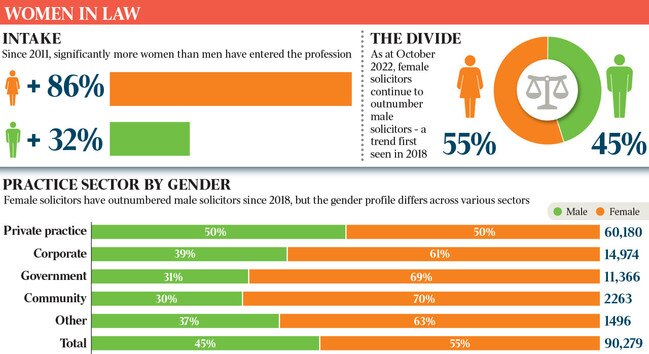Women tip the scales of justice in legal private practice
Private legal practices in Australia are for the first time seeing an equal number of men and women employed, in a growing trend promoting gender equality in a once male-dominated industry.

Private legal practices in Australia are for the first time seeing an equal number of men and women employed, in a growing trend promoting gender equality in a once male-dominated industry.
While there have been more female law graduates than male law graduates since 1993, this is the first time gender parity has been achieved in the private sector, according to research conducted by Urbis for the Law Society of NSW.
Law Society of NSW chief executive Sonja Stewart said the results indicated a changing attitude in women, who now see the legal industry as somewhere they could have a thriving career.
“It’s significant because while there have been more women than men entering the law for a while, this is the first time we’ve seen 50 per cent of men and 50 per cent of women in private practice,” she said. “Given a substantial majority (67 per cent) of Australian solicitors work in private practice, the achievement of gender parity marks a significant chapter in the development of the legal profession in this country.
“The law is a very attractive profession for women, and they are seeing more and more opportunities to be successful.”
Since 2012, the growth rate of female solicitors (up 86 per cent) has been significantly higher than that of male solicitors (up 32 per cent), and female solicitors now outnumber male solicitors in the community legal (70 per cent), government legal (69 per cent) and corporate legal sectors (61 per cent).
Ms Stewart said this was partly because of improved parental leave policies and better carers leave ushering women into the profession and allowing them to rise up the ranks.
“In regards to maternity leave and parental leave and flexible working, we can see that practices have improved, which make the workplaces much better for women,” she said.
While women now dominate various practice areas, this has not always been the case, as indicated by data revealing almost one half of males had been admitted for 15 years or more (49 per cent) compared with one-third of females (33 per cent).

Conversely, one-quarter of males had been admitted for five years or less (25 per cent) compared with one-third of females (34 per cent).
The research, published in a report titled the National Profile of Solicitors, provided demographic data about solicitors in all states and territories, as well as changes over time.
The distribution of solicitors in Australia has had minimal changes, with NSW maintaining the largest proportion of the nation’s solicitors with 42 per cent; Victoria has 25 per cent and Queensland 16 per cent.
Ms Stewart said efforts to increase the representation of Indigenous solicitors should be made because they were now less than 1 per cent of the profession.
“While the raw number of Aboriginal and Torres Strait Islander solicitors has risen from 632 to 749 since the 2020 National Profile, their proportion remains at 0.8 per cent,” she said.
“Internships and mentorship arrangements for Aboriginal and Torres Strait Islander lawyers are useful and provide good opportunities, but only for a relatively limited number of early-career solicitors in this cohort.”




To join the conversation, please log in. Don't have an account? Register
Join the conversation, you are commenting as Logout